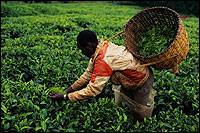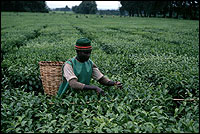|

More than 50 percent of export earnings are attributed
to agricultural products with the principal cash crops of coffee,
tea, tobacco, cotton, sisal, pineapples, wattle, pyrethrum, and
cashew nuts leading the way. The primary food crops are beans, cassava,
potatoes, maize, sorghum, and fruit. Maize is the most important
food crop; the government's goal is to achieve self-sufficiency
in major staples such as maize by 2010. Inadequate storage facilities,
little irrigation, recurrent drought and lack of incentives and
a severe shortage of arable land have restricted growth. 
The future of the sugar industry is threatened by cheap imports
from neighbouring countries following the removal of regional trade
barriers implemented by Comesa. Tea, coffee and horticultural produces
provided 52% of merchandise exports revenue in 1999. In the year
2000 coffee production improved by 53%. Exports of fruit, flowers,
and vegetables are also attracting an increasing amount of foreign
attention and money. Tea continues to create the largest agricultural
profit for Kenya.
Agriculture dominates employment and is comprised
of 50 per cent subsistence farming. There is an acute shortage of
arable land and uneven distribution has resulted in most farmers
working plots of two hectares or less. Landlessness, an annual population
growth of 2.9 per cent and rapid urbanization, place increasing
pressure on the ability of current food production and distribution
to meet demand at affordable prices. In addition, there is an ecological
risk to some of the most fertile areas of western and central Kenya,
which are already severely overpopulated. Both agricultural productivity
and population density are influenced by rainfall. The majority
of Kenya receives less than adequate rainfall needed to support
crop cultivation.  As
a result, the coastal area and Lake Victoria boast the most intensive
agriculture and greatest concentration of people. Pastoral farming
dominates the remaining drier regions of Kenya. Camels are common
in the arid desert areas while cattle, sheep, and goats dominate
the rest of the country.
Horticultural growth since the 1980s has been impressive, and most particularly over the past five years during which growth doubled. In 1999 it became the second-largest export earner, after tea, flowers making up the largest share.The government is attempting to protect timber resources, which are being depleted because of wood fuel demands, and the pressure for land. The government estimates that only 70 per cent of Kenya's wood fuel demands are met by regenerative growth. Some 38 million cubic metres of wood, or one million tonnes of oil equivalent (toe), are believed to be consumed annually.
|
|



